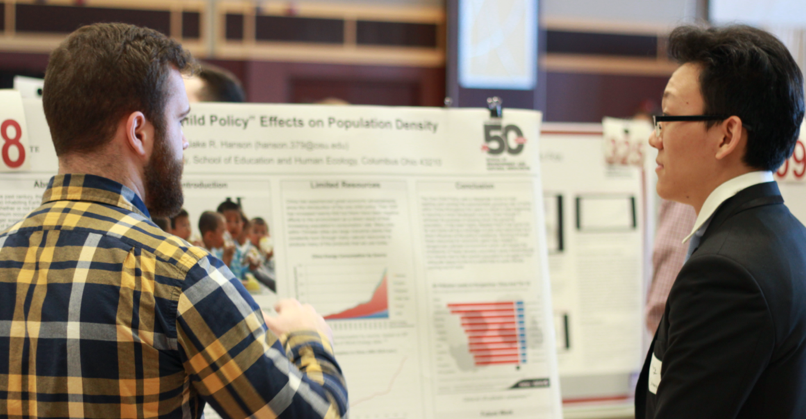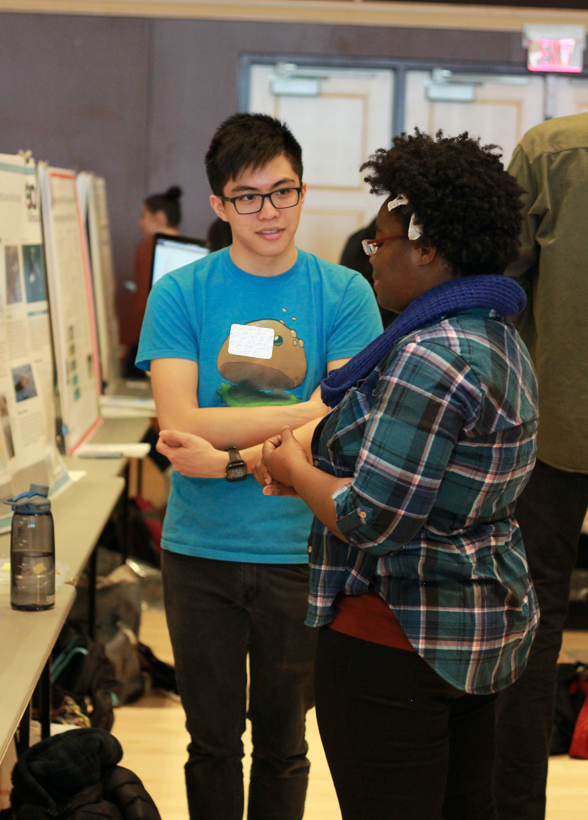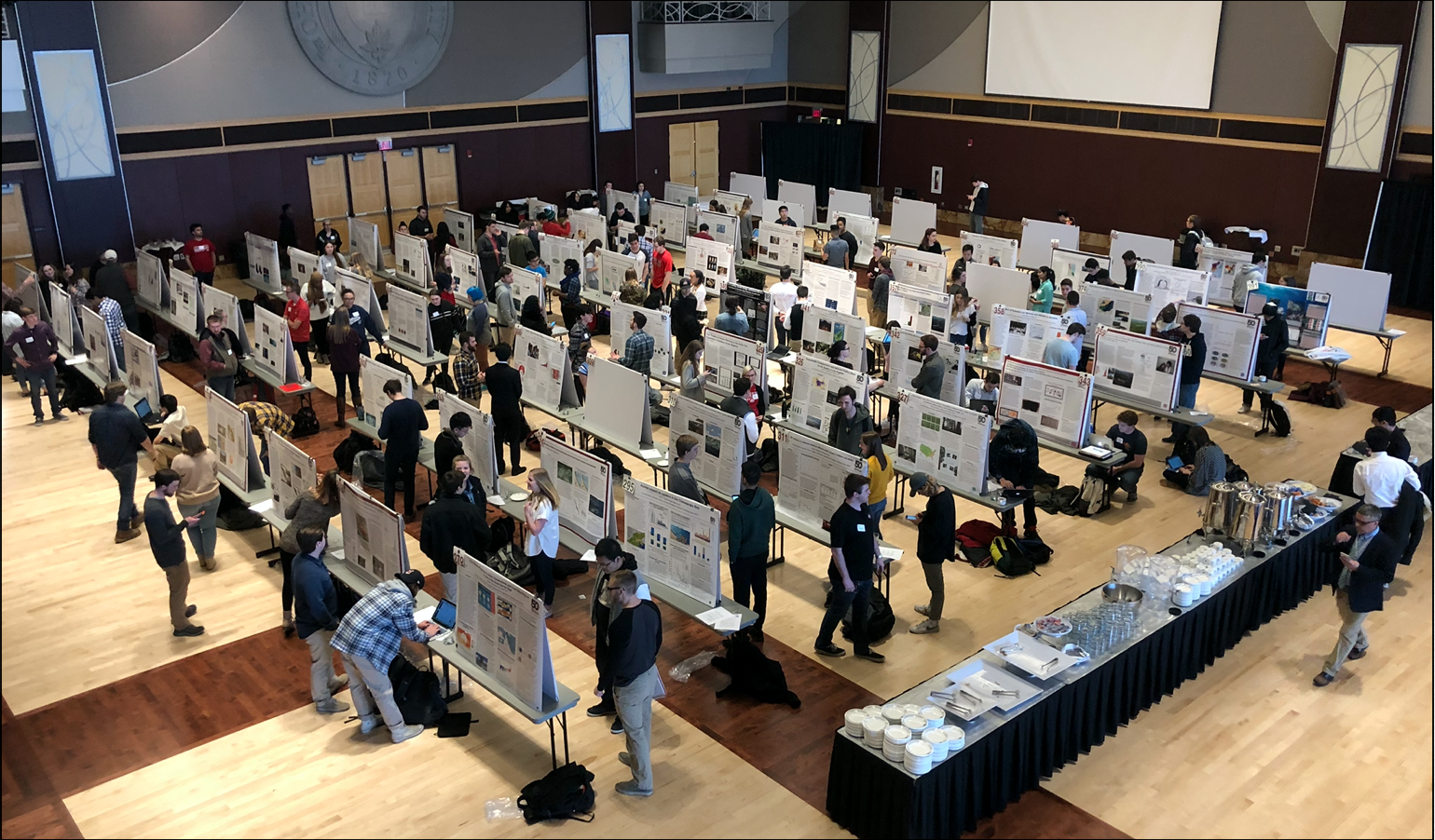Poster Presentation
Characteristics of a Poster Presentation
- Poster presenters should dress professionally and understand all parts of their poster.
- Most poster presentations take place in a large room with dozens to hundreds of individual poster presentations occurring simultaneously.
- A typical presentation lasts 5-15 minutes.
- Typical audience size for an individual poster presentation will be 1-5 people.
- It is acceptable for the audience to ask questions during a presentation.
- The presenter should use the poster’s figures and tables to communicate with the audience.
Excellent Presentations are Simple
The presenter is the scientist or engineer who conducted the research. The presenter is an expert in that particular field and should be confident (but not arrogant) when presenting the research to their audience. The presenter should understand everything that is in their poster (e.g., issue, topic, figures, tables, references). The presenter should relax, speak clearly, start with the introduction, move through the methods, results and end with the discussion section. The presenter should engage in conservation with the audience and answer their questions during the poster presentation. The presenter should not read word-for-word from a script, but rather they should follow a general progression through their poster (Fig. 17) that allows for active and organic discussion between them and the audience.
Figure 17. Poster Presentation

Tips for Giving a Poster Presentation
- Practice your presentation several times before the poster event. Dress professionally. Your audience will be focused on your poster for 5-15 minutes so you do not have much time to capture their attention and tell your story. Engaging figures, maps, and graphs will help capture their attention.
- Focus most of your presentation on your figures and tables. Your audience will focus on figures, graphs, tables, and maps. They rarely read the poster text. If they read any text at all, it will likely be the abstract and figure captions so a presenter really should focus on figures and tables when they prepare for their poster presentation.
- Speak clearly and know your topic. Remember you are the expert, so you need to understand all parts of your poster.
- Presenters should start their presentation (Fig. 17) by introducing themself and moving onto the Title and Introduction sections. Describe the issue and use figures to help explain the story. Use maps to show the study area, use photographs of the organism or pollutant or issue, use graphs and tables to show patterns (e.g., population increased over past 5 years) and focus on important points. Flow from one figure to the next, ending with the Discussion and Conclusion sections. The presenter should point to the poster when they are talking about a specific figure, and use words and their hands to help explain each part of the poster.
- Allow your audience to participate, allow them to ask questions throughout your presentation (Fig. 18). Always be respectful of your audience. Always try to answer their questions. If you do not know the answer, the best thing to say is “I do not know the answer, but I can point to another study here in my references section where other scientists are working on this very question.” Engage your audience and show them where to find additional work (e.g., journal articles, names of scientists) about the topic.
- Avoid using words like “stuff” and “things” and other general phrases like “this work was great”. Give specific details because this demonstrates to the audience that you understand your topic. Use the vocabulary words that you learned and explain these to the audience. For example, rather than saying “This work was great for orangutans,” you could say, “This work was great because it was the first time that we observed orangutan feeding behavior in the wild and it allowed us to determine that female orangutans need 5,500 calories per day during their breeding season. Those females that obtained 5,500 calories per day were twice as likely to give birth.”
- Be prepared for a lively and dynamic event (Fig. 19). Poster events typically consist of dozens or hundreds of individual poster presentations occurring simultaneously in the same room. These events are typically very loud and energetic. Food and beverages are typically provided at the event.
- Be flexible. The audience will walk around to view as many posters as possible, stopping occasionally to view a poster and talk to a poster presenter about their research. Some people may talk with the presenter for a few seconds, others may spend 15-20 minutes talking with a poster presenter. Presenter-audience interactions will be rather informal and dynamic.
- Read or download the poster guide and map prior to attending the poster event. A poster program guide and poster map will typically be published ahead of the event so that the audience knows where to find each poster and the presenter knows where to set up their poster.
- Wear comfortable shoes. Posters are typically displayed on an easel and the presenter stands by their poster during the entire event, which can several hours.
Figure 18. Two-Way Communication is Key to a Successful Poster Event

All scientific posters follow a similar organization in terms of parts (i.e., Abstract, Introduction, Materials & Methods, Results, Discussion, References) and layout (i.e., title and name at the top, 3-4 columns for content). However, each scientific poster can be unique in terms of its font, color scheme, types of figures (e.g., chart, diagram, graph, map, photograph) and use of tables. It is entirely up to the scientists to decide how they want to design their poster to best communicate their research with the audience. Gallery 1 shows eight different scientific posters that were presented at a scientific conference. As you look through Gallery 1 you can see that the posters are all similar in the way that they are organized but that each poster is unique in they way it is designed (e.g., color scheme, number and placement of figures, use of fonts). While each is different, they all succeed in their goal of visually communicating the importance of their scientific research to an audience (Gallery 1).
Figure 19. Poster Event

